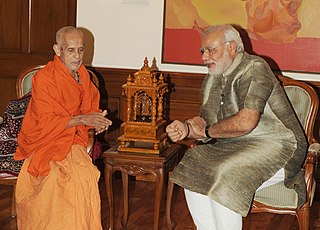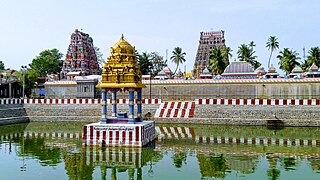
Lake Manasarovar, also called mTsho Mapham or mTsho Ma-dros-pa locally;, is a high altitude freshwater lake fed by the Kailash Glaciers near Mount Kailash in Burang County, Ngari Prefecture, Tibet Autonomous Region, China. The lake along with Mount Kailash to its north are sacred sites in four religions: Bön, Buddhism, Hinduism and Jainism.

Osian is an ancient town located in the Jodhpur District of Rajasthan state in western India. It is an oasis in the Thar Desert. The town is a panchayat village and the headquarters for Osian tehsil. It lies 69 km (43 mi) by road north of the district headquarters at Jodhpur, on a diversion off the main Jodhpur – Bikaner Highway. The under-construction Amritsar Jamnagar Expressway passes through this town.
Vrata is a Sanskrit word that means "vow, resolve, devotion", and refers to pious observances such as fasting and pilgrimage (Tirtha) found in Indian religions such as Jainism and Hinduism. It is typically accompanied with prayers seeking health and happiness for their loved ones.

A matha, also written as math, muth, mutth, mutt, or mut, is a Sanskrit word that means 'institute or college', and it also refers to a monastery in Hinduism. An alternative term for such a monastery is adheenam.
Tirtha is a Sanskrit word that means "crossing place, ford", and refers to any place, text or person that is holy. It particularly refers to pilgrimage sites and holy places in Hinduism as well as Jainism.

In Jainism, a tīrtha is used to refer both to pilgrimage sites as well as to the four sections of the sangha. A tirtha provides the inspiration to enable one to cross over from worldly engagement to the side of moksha.

Siddhachalam is the first Jain Tirtha located outside of India. Founded in 1983 by Sushil Kumar, it is located on a 108-acre (44ha) site in rural New Jersey, United States. Siddhachalam literally means the abode of liberated souls.

Sri Vadiraja Tirtharu was a Dvaita philosopher, poet, traveller and mystic. A polymath of his time, he authored many works, often polemical, on Madhva theology and metaphysics. Additionally, he composed numerous poems and as the pontiff of Sodhe Mutt, renovated the temple complex at Udupi and established the Paryaya system of worship. He is also credited with enriching the Kannada literature of the time by translating Madhvacharya's works to Kannada, giving impetus and contributing to the Haridasa movement. He has influenced both Carnatic and Hindustani music through his compositions. His compositions are mainly in Kannada and Sanskrit. His mudra is 'Hayavadana'. His works are characterised by their poetic flourishes, incisive wit and humour.

A Jain temple or Derasar is the place of worship for Jains, the followers of Jainism. Jain architecture is essentially restricted to temples and monasteries, and Jain buildings generally reflect the prevailing style of the place and time they were built.

Yātrā, in Indian-origin religions, Hinduism, Buddhism, Jainism and Sikhism, generally means a pilgrimage to holy places such as confluences of sacred rivers, sacred mountains, places associated with Hindu epics such as the Mahabharata and Ramayana, and other sacred pilgrimage sites. Visiting a sacred place is believed by the pilgrim to purify the self and bring one closer to the divine. The journey itself is as important as the destination, and the hardships of travel serve as an act of devotion in themselves.

Madhva Tradition (originally named Sadh Vaishnavism and Brahma Sampradaya, is a denomination within the Vaishnavism—Bhagavata tradition of Hinduism, founded by the thirteenth century philosopher Madhvacharya. It is a movement in Hinduism that developed during its classical period around the beginning of the Common Era. Philosophically, Madhva tradition is aligned with Dvaita Vedanta, and regards Madhvacharya as its founder or reformer.

Pejavara Matha is one of the Ashta Mathas of Udupi, which was started by Sri Adhokshaja Tirtha, who was a direct disciple of Sri Madhvacharya, the founder of the Dvaita school of Hindu philosophy. Till date, 32 Swamijis have headed this matha. The current Swamiji is Sri Vishwaprasanna Tirtha Swamiji.He ascended the Vedanta Peetha after the death of his predecessor and Guru H. H. Sri Sri Vishvesha Tirtha Swamiji on 29 December 2019.

Puthige Matha or Puttige Mutt in some records and literature is a Madhwa Vaishnava monastery. It is one of the Ashta Mathas of Udupi founded by Dvaita philosopher Madhvacharya of Udupi. The first pontiff of Puttige matha was Sri Upendra Tirtha, who was a direct disciple of Sri Madhvacharya, the founder of the Dvaita school of philosophy. The main idols worshipped in the Puttige matha are that of Panduranga (Vittala), which was given to Sri Upendra Tirtha by Sri Madhvacharya. Till date, there have been 29 pontiffs who have headed the matha.
Siddhayatan, is a Jain-Hindu Tirth in North America founded in 2008 by Acharya Shree Yogeesh. It is located on a 250-acre (1.0 km2) site at Windom near Dallas, Texas, United States. Siddhayatan currently has miniatured versions of pilgrimage sites from India, including Kailash-Mansarovar, Lake Rakshastal, Ashtapad, Sammedshikhar, Bahubali, and thus is considered as a pilgrimage rather than a temple or place of worship or prayer. According to India Abroad, it is a “Spiritual Disneyland”. The tour of the entire pilgrimage is estimated to be 4 hours.

The Char Dham is a set of four pilgrimage sites in India. It is believed that visiting these sites helps achieve moksha (salvation). The four Dhams are, Badrinath, Dwarka, Puri and Rameswaram. It is believed that every Hindu should visit the Char Dhams during one's lifetime. The Char Dham as defined by Adi Shankaracharya consists of four Hindu pilgrimage sites. These main 'dhams' are the places of Lord Vishnu and Rameshwaram is of lord Shiva. All the 'dhams' are related to four epochs,(1) Dham of Satyug- Badrinath, Uttarakhand (2) Dham of Tretayug -Rameshwaram, Tamil Nadu (3) Dham of Dwaperyug - Dwarika, Gujarat (4) Dham of Kaliyug - Jaganath Puri, Odisha.

Shri Uttaradi Math, is one of the premier monasteries (matha) founded by Madhvacharya to preserve and propagate Sanatana dharma and Dvaita Vedanta (Tattvavada) with Padmanabha Tirtha as its head. The Uttaradi Math is an important institution among the Madhvas and also deeply respected among the Vaishnavas and the other Hindus. Most of the Deshastha Madhvas and majority of Madhvas outside Tulu Nadu region are followers of this matha. Uttaradi Math has followers across Karnataka (outside Tulunadu region), Maharashtra, Andhra Pradesh, Telangana, Madhya Pradesh, Tamil Nadu and Bihar regions.

Theertham literally refers to water. In Hindu sacred literature, it is referred to as the physical holy water body associated with a temple or deity. As per Hindu religious belief, water is the principle purification mechanism. While external purification is believed to be through a dip in sacred water bodies, internal purification is through truthfulness. Most Hindu temples are associated with bodies of water, which are called Theertham. In Vishnu temples, devotees are offered a few drops of sacred water called Theertham.

Tirth Pat is a religious map and topographical rendering used in Śvētāmbara Jainism religion for representing places of pilgrimage (Tirtha). Tirth Pat is different than the conventional map making and is not drawn to scale. Tirth Pat is not indicative of distances, elevation, topography and direction and is solely used for evocation of Jain pilgrimages (Tirthas). It is believed in Jainism that mere viewing of a Tirth Pat earns merit for a devotee.

Navagraha Jain Temple or Navagraha Teertha or Navagraha Tirtha is situated at Varur near Hubli, Karnataka. Navagraha Teertha is one of the major pilgrim spots for the Jain community in India. The temple features a 61-foot (19 m) tall monolithic idol of the Shri 1008 Bhagavan Parshvanatha and the smaller statues of the other eight Jain teerthankaras. The statue is the tallest statue of the Jain deity Parshvanatha in India and weighs 185 tons. The statue stands on a 48-foot (15 m) high pedestal(109-foot total).

48 kos parikrama is a Hindi phrase meaning a 48 kos circumambulation parikrama (pilgrimage) of various Mahabharata-related and other vedic era tirthas around the holy city of Kurukshetra in the state of Haryana, India. There are several pilgrimages around the city of kurukshetra and a complete parikrama means to visit all these pilgrimages. The picture depicts the complete map of all these sites.
















